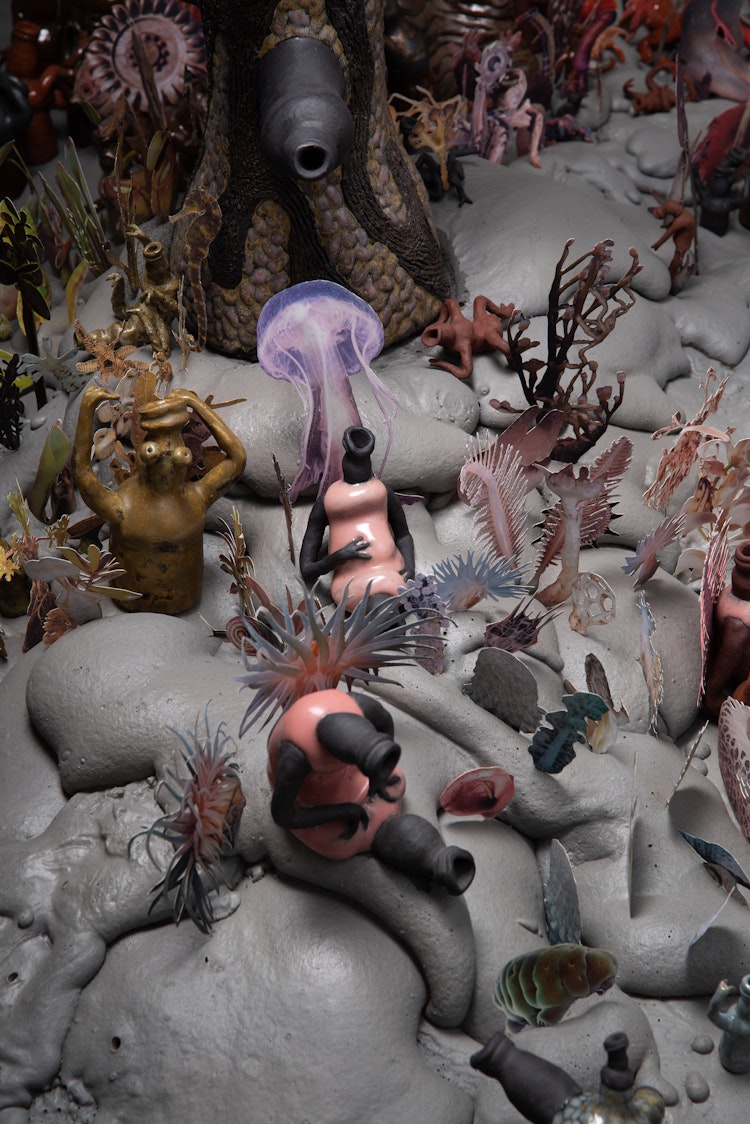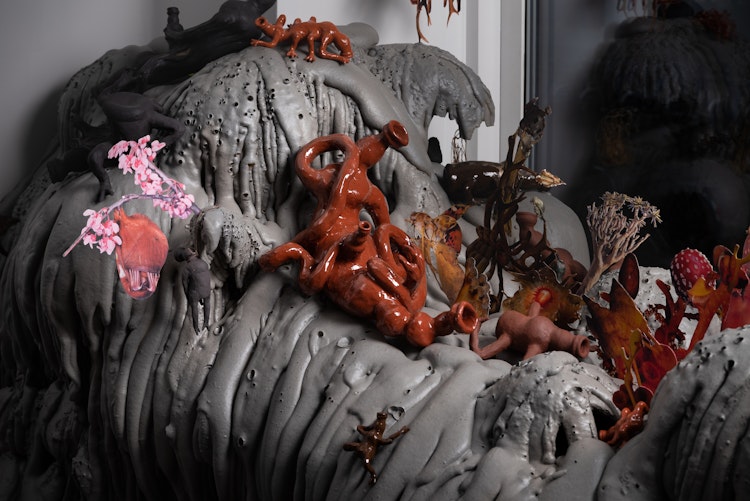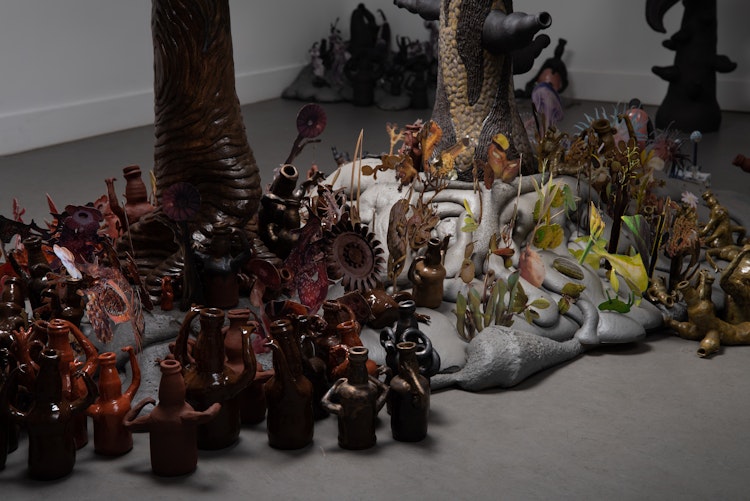

Tommy Olsson
In this essay, art critic Tommy Olsson reflects on Ingrid Askeland and Hilde Jørgensen's exhibition Manic Monday, a dystopian installation of ceramic sculptures, photography and collage, that was on display at Kunstnerforbundet in Oslo in the autumn of 2019.
Things are getting serious. As most people now realise. The future is shaping up to be an over-heated desert ruled by Nazis, where it isn’t just every form of state funding for culture that has been phased out, but also anything else that could be seen as a defining feature of the State. What one has to ask in such tense and uncomfortable times is whether things weren’t already serious in the past. Whether it’s new that the crisis (crises) can no longer be ignored. And, of course, whether the profession of art critic is essentially a matter of identifying changes and connections in time and space, or – as some believe, and they do have a point – an utterly obsolete pursuit, given the vast darkness that is now bearing down on us. The fact that I am still sitting here doing what I have always done is not meant to discredit those who believe the latter, but rather the upshot, firstly, of my failure to find anything else I could do better, and secondly, of realising that the world would be even more depressing if I didn’t give a shit about work. My reasons for saying this have more to do with time than space, on top of which the issue here is one that will affect anyone who writes about the visual arts at some point or other – the need to say something about an artist’s work that you’ve already said many times before. Despite the fact that over the years the artist, her work, and one’s own far less agreeable self has all changed, the writer will always find himself on a tightrope over the abyss, and the longer the time since the first meeting, the slacker the line.
It’s now some thirteen years since I first wrote about the work of Ingrid Askeland and her now iconic monumental-sized beer bottles that served as a medium for describing the kind of progression we tend to describe as “get wasted and fuck shit up”, within the social context where beer serves as the essential social lubricant behind the liberating condition known as being “totally shitfaced”. Not without reason, I have in retrospect reflected on the kinship to various local icons, such as Bror Wyller and Christopher Nielsen, albeit – as one would expect – under the assumption of a different perspective: Askeland is a younger woman working in a landscape largely defined by older men. The kind of social realism where you’re likely to fail miserably unless you have a sense of humour – by which I mean a sense that’s well-developed and a humour so refined as to be way above the heads of less contemplative teetotallers.


But what we have here is something different. In the company of collages by Hilde Jørgensen – very old-school in their method, and out-and-out abstract in composition, blown up to a size that makes them thoroughly and disturbingly effective – Askeland’s ceramics expand through the room like some organic nightmare. In size everything has been reduced to the level of the model builder, but in scope the display is as insane as a 1980s Pushwagner drawing – you couldn’t take it all in without spending countless hours in Kunstnerforbundet’s Window Room. An enchanted forest. An utterly ghastly enchanted forest. Imagine the nocturnal landscape of Tove Jansson’s Who Will Comfort Toffle? seen through the helpless paranoid gaze of a heroin addict who, fifteen minutes after shooting up, is desperately trying to comprehend the question he has just been asked by an impatient cop. Or a world where natural disasters have become so routine that there’s no point in long-term planning. The connection to the oversized beer bottles I first encountered, in a very different world, is evident in the swarm of insects and reptiles, produced by some artistic mutation, with bottle necks where their heads ought to be. We find ourselves in the vicinity of that cartoon-style symbolism that shows the habitual drinker trapped inside a bottle, although what we have here – lizards, locusts, or whatever they are – is difficult to accommodate in any existing framework, and the one thing it certainly is not is some kind of one-dimensional warning against the tyrannical nature of alcohol dependency. For that, the landscape these creatures inhabit is too complex and unpredictable. As complex and unpredictable, in fact, as the real world. There is a fecundity here of an awkward Chernobyl kind, something beyond pessimistic. On one little twig I find a man swinging by the neck, a motif that is evidently important enough to be repeated several times – although, as with anything else, you have to know what you’re looking for to have a chance of finding it; it was mere happenstance that I noticed the first one, which led to me being told about the other two. Who knows what else might be lurking in this throng?

Hilde Jørgensen’s collages, which brutally recombine things we recognise, or like to think we recognise – such as elements from the easily digestible visual material and incidental photographs of various glossy magazines and science textbooks, where blue signifies sky, and the ground we stand on wavers between grey and beige – with things we don’t recognise at all. No, I really can’t say. Crystals? Metals? Some kind of geological research, documented in black and white? There certainly isn’t any need for something to complement Askeland’s apocalyptic version of a witch’s forest – where a gingerbread house must be hidden away somewhere or other – yet that’s how they function, quite probably as a result of doing nothing more spectacular than hanging on the wall, where they do not so much correspond to the visions spreading out across the floor as directly underline them. I catch myself wondering what they would look like if they were the only thing in the room – or in any room – and end up thinking of them as something very basic. Something you can always rely on in any context to act as an amplifier for something else – which is definitely how they work at Kunstnerforbundet, although I suspect they would work in much the same way together with other things by other artists. There’s something very solid about them. Perhaps it’s something as simple as the dynamic between the recognisable and the genuinely alien that produces dependability? Who hasn’t sat down with a pile of magazines, scissors and glue, and aimlessly begun to arrange and re-arrange the world, only to discover the future emerging like a slow-motion film? After all, this is what collage is all about. So, what would the effect be if they were on their own? I admit the question is irrelevant, but that doesn’t stop it from hanging about in the back of my mind and adding to the buzz of everything else; unpaid bills and childhood memories, all the kind of baggage you carry around with you.
Who hasn’t sat down with a pile of magazines, scissors and glue, and aimlessly begun to arrange and re-arrange the world, only to discover the future emerging like a slow-motion film? After all, this is what collage is all about.
Size is undoubtedly a factor determining whether or not the formula works. The ceramics seem diminished, the collages enlarged. In her development Askeland has moved on from something familiar and unnaturally large to something chaotic and substantially smaller. To wander around in this as a visitor is a bit like exploring Lilliput. Spilling out from the welter of creatures in the window, where one usually has a chance to sit, various hordes spread across the floor forming colonies, or islands, so that in many ways one has the feeling of moving around inside a map. With so much concentrated on the floor itself – which makes it necessary to walk around with a stoop, your eyes glued to the ground, either squinting or fumbling through inner pockets in search of your glasses – one also becomes aware of the broader perspective, of the room as a whole, to the benefit of the details – which, as already mentioned, are so numerous as to require oodles of time to take them all in. And of course, it is also as a unified whole that they have to be understood. As a swarm we are inclined to recognise them as replicating what is going on in the world outside, where at any one time you’re likely to find a far larger number of men swinging by the neck, people who have actively chosen to shake off the mortal coil on recognising the impossibility of existing on their own terms in the vast majority of circumstances. The loss of hope shifts between being liberating and utterly destructive. The world we stand there gawping at when it collapses in front of our eyes is essentially constructed from words, and hence, by extension, from the various delusions those words give rise to – meaning that reasons to hang oneself are as likely to spring from the failure to shake off that irritating propensity for hope that is forever conjuring up castles in the air, illusions we eventually realise have nothing whatsoever to do with actual circumstances. At least hopelessness offers a unique opportunity to see the world as it really is.

I don’t mean to suggest that I possess some kind of knowledge hidden to others; when it comes to understanding the condition of the world and how it ticks, I have progressed from extreme insecurity to a state of totally fucking lost. But my guess is that when seen from above, as a whole, the planet must look like an anthill governed by arbitrariness and a total lack of order, or it’ll look like it does when you stand up straight and have the impression that everything and everyone has become a reptile or an insect with the neck of a bottle instead of a head – a focal point for energy and desire. For some reason I’m reminded of a 1960s Danish Super-8 porn film I have lying about somewhere, in which a Carlsberg bottle has, as it were, the lead role. As we all know, time and space are little more than a trick with mirrors. The rest is formulations that are forever being reformulated.